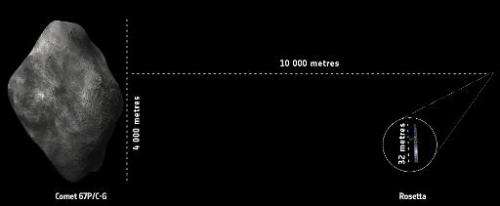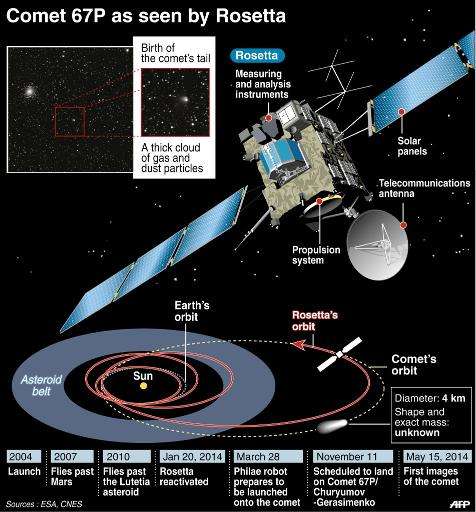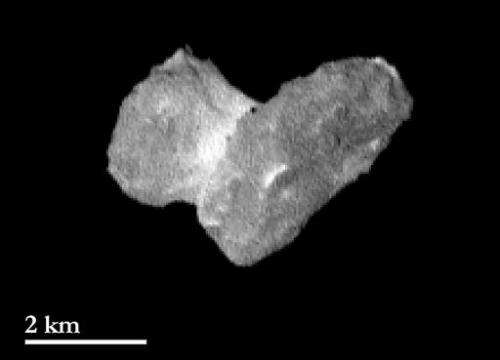Fingers crossed as comet-chaser nears end of trek

European scientists were preparing for a historic rendezvous on Wednesday between a comet and a space probe after a 10-year, six billion-kilometre (3.7-billion-mile) chase through the Solar System.
The scout Rosetta is on track for meeting Comet 67P/Churyumov-Gerasimenko in deep space, when it will become the first envoy of Man to orbit one of these wanderers of the Solar System, they said.
If all goes well, the mission in November will carry out the first landing on a comet.
Rosetta will send a robot chemistry lab to the surface to delve into a theory that comets hold the key to understanding how our star system formed.
"After completing a complex series of nine orbital manoeuvres since the end of hibernation on January 20, Rosetta is finally in position to rendezvous with the comet," the European Space Agency (ESA) said on Tuesday.
Orbital entry will be triggered by a small firing of her thrusters, lasting just six minutes and 26 seconds, starting at 0900 GMT on Wednesday, it said.
"This burn will tip Rosetta into the first leg of a series of three-legged triangular paths about the comet," it said.
Top officials from ESA will be at mission control in Darmstadt, Germany, waiting for the signals to start and stop this crucial final operation to be safely received by ground monitoring stations, 22 minutes later.

The "pyramidal" orbits will put the craft at a height of about 100 kilometres (60 miles) above the comet, said Sylvain Lodiot, Rosetta's flight operations manager. Each leg of the triangle will be around 100 kilometres and take Rosetta between three and four days to complete.
The arrival will mark a key moment of the boldest project ever undertaken by ESA—a 1.3-billion-euro ($1.76-billion) investigation into one of enigmas of the Solar System.
Comets are believed by astrophysicists to be ancient ice and dust left from the building of the Solar System around 4.6 billion years ago. This cosmic rubble is the oldest, least touched material in our stellar neighbourhood.
Understanding its chemical ID and physical composition will give insights into how the planets coalesced after the Sun flared into light, it is hoped.
It could also determine the fate of a theory called "pan-spermia," which suggests comets, by smashing into the infant Earth, sowed our home with water and precious organic molecules, providing us with a kickstart for life.
Navigational feat
Rosetta is poised to meet up with Comet "C-G" more than 400 million kilometres from where it was launched.

Getting there has been an unprecedented navigational exploit.
Launched in March 2004, the three-tonne craft has had to make four flybys of Mars and Earth, using their gravitational force as a slingshot to build up speed.
It then entered a 31-month hibernation as light from the distant Sun became too weak for its solar panels. That period ended in January with a wake-up call sent from Earth.
The spacecraft is named after the famous stone, now in the British Museum, that explained Egyptian hieroglyphics, while its payload Philae is named after an obelisk that in turn helped decipher the Rosetta stone.
The four-kilometre comet is named after two Ukrainian astronomers who first spotted it in 1969.
Rosetta mission: A timeline
Europe's comet-chasing probe Rosetta has required 10 years, six billion kilometers (3.75 billion miles) and three gravitational pushes from Earth and one from Mars to arrive at its target.
The unprecedented flight profile has been likened by the European Space Agency (ESA) to a game of "cosmic billiards".
It was needed to help Rosetta to catch up with Comet 67P/Churyumov-Gerasimenko, which loops around the Sun at up to 135,000 kilometers (84,375 miles) per hour.
Here is a timeline of the mission:
- March 2, 2004: Liftoff from ESA's launchpad in Kourou, French Guiana by an Ariane 5 rocket.
- March 2005: A year after launch, Rosetta encounters the Earth, using the planet's gravity as a slingshot to boost speed.
- February 2007: Flies around Mars at a distance of just over 200 kilometers (120 miles) for a gravitational assist.
- November 2007: Second Earth flyby.
- September 2008: Rosetta flies by asteroid 2867 Steins at a distance of around 800 km.
- November 2009: Third Earth flyby. Rosetta now at top speed as it flies through the asteroid belt. Gets a close observation of the space rock 21 Lutetia (July 2010).
- June 2011-January 20, 2014: At maximum distance (800 million km) from the Sun and a billion kms from home, Rosetta goes into hibernation to conserve energy.
- January-May 2014: Rosetta gets the wakeup call to end its long slumber, fires thrusters to gradually brake its speed and near the comet.
- August 6, 2014: Rosetta scheduled to arrive at the comet and begin triangular orbits around it at a height of 100 kms. Over the next three months, it will scan the comet's surface and sub-surface with 11 onboard cameras, radar, microwave, infrared and other sensors.
- November 11, 2014 (scheduled): Rosetta sends down a 100-kilogramme (220-pound) robot laboratory, Philae. The lander, equipped with 10 instruments, is released at a height of about one kilometer (half a mile), touching down at walking speed. It fires a small harpoon to anchor itself, starts to send back pictures and conducts chemistry experiments on rock samples.
- November 2014-2015: Comet Churyumov-Gerasimenko loops around the Sun, approaching on August 13, 2015 to within 186 million kms (116 million miles) of our star.
- December 2015: Scheduled end of mission. Escorted by Rosetta and with little Philae piggybacking on it, the comet heads out of the inner Solar System. At this point, Rosetta will once again come close to Earth's orbit, more than 4,000 days after its odyssey began.
© 2014 AFP



















